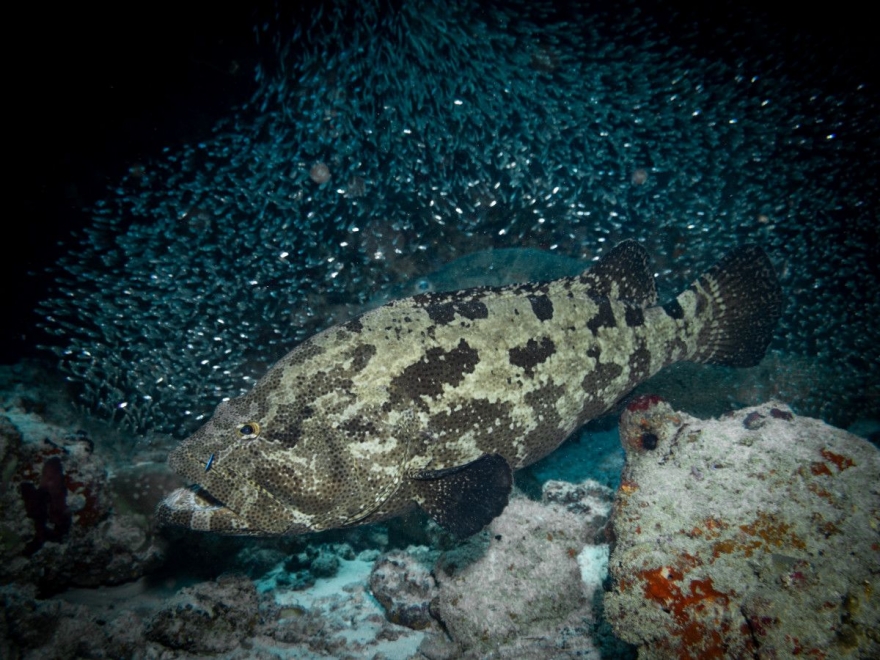
Maldives has introduced new measures to curb the decline of wild grouper, a coral reef fish vital for reef health. The new measures include revised minimum size limits for the most highly valued grouper species, based on evidence collected by the Maldives Marine Research Institute (MMRI), formerly Marine Research Centre and Blue Marine Foundation (BLUE).
Groupers are a diverse group of coral reef fish and are valued by divers and snorkelers due to their large size and impressive colours. However, the capture of groupers for the live reef fish trade to South Asia is threatening their populations.
The MMRI reported that, within just five years of the export fishery starting, grouper stocks were already declining. In 2011, research by MMRI found that 70 per cent of groupers landed for the export trade were immature and their latest research (published in 2020) shows that 90 per cent of the most highly valued grouper species landed are immature (see images below). This is because groupers are highly susceptible to overfishing. They are long-lived, take a long time to reproduce and they change sex as they grow. Crucially, they aggregate to breed in the same locations at predictable times of the month, making them easy targets for fishermen.
Groupers across the world are globally threatened due to this trade and at least two of the species found in Maldives are listed as Vulnerable on the International Union for Conservation of Nature’s Red List. In recent years, many island nations like Fiji and Seychelles have started to take control by preventing export of these valuable fish. Now, Maldives is the only country in the Indian Ocean still exporting live groupers.
The new ‘Grouper Fishery Management Plan’ published in December 2020 stipulates that it is illegal to fish, keep on board, store, tranship, land, process, retain in a processing facility, export and attempt to export 23 species of groupers below their size limits. The plan gives the Ministry one year to enforce and implement the size limits. However, it is expected to come into force much earlier, following the publication of the new Grouper Fishery Management Regulation in the Government Gazette.
The Maldives Fisheries, Marine Resources and Agriculture Minister, Ms. Zaha Waheed commented“Groupers occupy a fundamental niche in the ecosystem and their fishery and trade are lucrative economic activities in the Maldives. In light of the increasing threats to reef and reef associated fishes such as groupers, we aimed to introduce effective and timely management measures to protect their spawning stock and safeguard the livelihoods of those who are dependent on this important resource. This new management plan has been formulated through a rigorous consultation process and encompasses the principles of equity,sustainability and Ecosystem Based Management”
New minimum landing size limits have been introduced for Brown marbled grouper (60cm), Camouflage grouper (40cm), Squaretail coral grouper (40cm) and Roving coral grouper (42cm). The revised size limits of these four species are in some cases 20cm greater than those stipulated in the previous regulations.
Professor Callum Roberts of Exeter University in the UK who has studied coral reefs for more than 25 years commented: “Minimum landing sizes must be bigger than the size of sexual maturity because newly mature fish are small and contribute very little to stock replenishment. Big fish are the engines of reproduction, producing far more eggs than many small fish combined. Fish need to be kept in the water longer to grow bigger and ensure that Maldivian groupers recover to more productive levels.”
The new plan extends the timeframe of protection for five spawning aggregation sites to a further ten years and clearly defines the activities that are prohibited. No fishing is allowed at these sites except for trolling. Diving and snorkelling, use of motorized vehicles for water sports activities and the use of lights are prohibited at these sites between 23rd-3rd day of the lunar period.
A total ban on the use of pressurized air, torches or lights, in association with gaffs for this fishery and the use of spears and gaffs to target grouper spawning aggregations will be enforced. These will also come into effect upon the publication of the new regulation.
Shaha Hashim, Maldives Project Manager at BLUE, said: “Spawning aggregations are the sole opportunity for groupers to reproduce. These spawning sites can be quickly eradicated due to fishing pressure, and once gone, they are not known to recover. Fishermen from across Maldives have reported that some aggregations have already disappeared. While it is encouraging to see the timeframe extension of the five sites previously protected on paper, there is an urgent need to effectively protect at least one spawning site from each atoll of Maldives, if we are serious about managing our wild grouper stocks.
These new measures are crucial to safeguard the livelihoods of over 700 grouper fishers who are active in 13 atolls and 31 islands across the country. The Ministry also makes clear their intention to use aquaculture of groupers to create market opportunities and reduce pressure on the wild stock. However, experts urge the Government to exert caution.
Professor Yvonne Sadovy, a Professor at the University of Hong Kong and co-Chair of the IUCN Groupers & Wrasses Specialist Group, said: “Wild capture and aquaculture are two different forms of production and both are practiced side by side. Therefore, aquaculture does not, in practice, reduce pressures on wild stocks. Indeed, if feed and seed are taken from the wild, culturing actually increases and worsens pressure on wild populations and on the marine ecosystem.”
Fisheries management plans have recently been accorded recognition within the legislative framework of Maldives under the new Fisheries Act passed in September 2019. Until now, there were only two fisheries with management plans in the country – live bait and grouper. The new plan comes alongside other new fishery plans for reef fish, billfish, lobster, sea cucumber, marine aquarium fish and diamondback squid.
The new Grouper Fishery Management Plan (Volume 40, No. 260) can be found here.
Please login to Comment